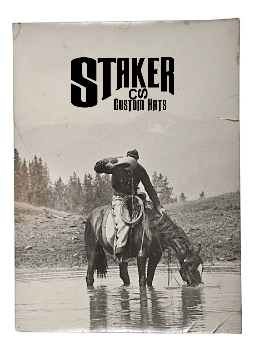The Story Of The Cowboy 1898 by E. Hough
The Hat of the cowboy is one of the typical and striking features of his costume, and one upon which he always bestows the greatest of care. The tenderfoot is known upon the range by his hat. He thinks it correct to wear a wide white hat, and so buys one for a couple of dollars. He is pained and grieved to find that at the ranch he is derided for wearing a “wool hat,” and he is still more disconnected with his head covering when he finds that the first heavy rain has caused it to loop down and lose all its shape. The cowboy riding by his side wears a heavy white bever felt hat with a heavy leather band buckled about it, which perhaps he bought five years before at cost of fifteen or twenty dollars; but he refers with pride to the fact that is a “genuine beaver, “an’ a shore good un” There has been no head covering devised so suitable as this for the uses of the plains. The heavy texture of this bever repels the blazing rays of the sun better than any helmet. There are no recorded cases of sunstroke on the range. The record might be different were straw or “derbys” substituted for the rational headgear which for so long has been accepted thing in cowboy country. The cowboy can depend upon his hat at all seasons. In the rain it is an umbrella. In the sun it is a shade and safeguard. At night, if he sleeps cold, he can place it beneath his hips, and in the winter he can tie it down about his ears with a handkerchief, thus escaping the frostbite which sometimes assails tenderfeet who rely upon the best caps with ear-flaps.
The straight-sided, round cornered, flat brimmed original Boss of the Plains design dominated for about twenty years. Most 19th-century photographs that show the hat don’t show an intentional crease at all. Most hats were kept open crown. However, through use, abuse, and customization by individual wearers, hats were modified from their original appearance. In particular, the crown would become dented, at first inadvertently, then by deliberate choice of individual owners. The brim was often rolled or curved and ornamentation was sometimes added. Often, these creases and brim shapes began to reflect where a particular hat owner lived or worked, and in some cases, even cowboys on individual ranches could be identified by the crease in their hat.
For years, Stetson worried about the waterproofing, and finally decided to make his hat of beaver felt. It took about 42 beaver belly pelts to produce a high quality hat. Because of the tight weave of most Stetson hats, it was waterproof enough to be used as a bucket. One story tells of a cowboy crossing a long dry stretch of prairie. His canteen sprung a leak. He saved the drinking water by carrying it in his Stetson. Stetson featured advertising of a cowboy watering his horse with water carried in the crown. The wearer could also use the brim to direct water to a person’s mouth. A high quality hat in good condition was also viewed in some places as a status symbol
